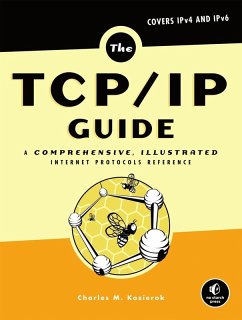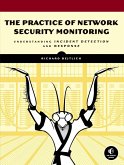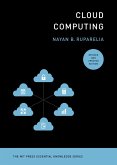From Charles M. Kozierok, the creator of the highly regarded www.pcguide.com, comes The TCP/IP Guide. This completely up-to-date, encyclopedic reference on the TCP/IP protocol suite will appeal to newcomers and the seasoned professional alike. Kozierok details the core protocols that make TCP/IP internetworks function and the most important classic TCP/IP applications, integrating IPv6 coverage throughout. Over 350 illustrations and hundreds of tables help to explain the finer points of this complex topic. The book's personal, user-friendly writing style lets readers of all levels understand the dozens of protocols and technologies that run the Internet, with full coverage of PPP, ARP, IP, IPv6, IP NAT, IPSec, Mobile IP, ICMP, RIP, BGP, TCP, UDP, DNS, DHCP, SNMP, FTP, SMTP, NNTP, HTTP, Telnet, and much more. The TCP/IP Guide is a must-have addition to the libraries of internetworking students, educators, networking professionals, and those working toward certification.
Dieser Download kann aus rechtlichen Gründen nur mit Rechnungsadresse in A, B, BG, CY, CZ, D, DK, EW, E, FIN, F, GR, HR, H, IRL, I, LT, L, LR, M, NL, PL, P, R, S, SLO, SK ausgeliefert werden.
"A New TCP/IP Classic. . . Keeps things interesting and flowing well enough that working one's way through. . . Actually entertaining instead of torture."
Slashdot
"The most comprehensive guide to TCP/IP protocols we have ever come across. It also is the most readable. This is a book that will be staying on our shelves, and we highly recommend it."
Network World
This is a really well-done book, and well worth the price if you need up-to-date, easy-to-digest information about TCP/IP. I wish I'd written this puppy.
IBM s developerWorks
Nicely organized, from an introduction to networking through administration and troubleshooting, the book clearly explains each topic.
Library Journal
"I've never seen a book on this subject before to match this one . . . It's as close to indispensable as a printed work can get."
NetPerformance.com
"The book is well-organized, well-illustrated, and has a conversational tone that makes it easy to read and learn even for networking novices."
Windows Networking
"It's informative and easy to read, even when discussing rather nasty protocols, and when it covers something, it generally covers it quite completely."
;login:
"Due to size, it may seem like this book is solely for students or engineers. However, The TCP/IP Guide is great for anyone and everyone as it can act both as a reference guide and a textbook."
Linux Security
"The author does a great job of discussing the significance of the information he is presenting . . . Whereas some books seem to throw illustrations in simply to break up the text, this book adds just the right amount in the right places to make sure you understand."
Linux Magazine
"Covers a great breadth and depth of information . . . an excellent reference." (4.5 out of 5 stars)
About.com
"This is both an encyclopedic and comprehensible guide to the TCP/IP protocol suite that will appeal to newcomers and the seasoned professional."
DominoPower Magazine
Kozierok's description of IPv4 addressing is probably the clearest I have ever read. And his chapters about IP subnetting and classless addressing are masterful. If I ever teach communication protocols again, my lecture notes will owe a great deal to this book. . . I continue to be astounded that this much information, presented in a clear and entertaining fashion, is available for so little.
Kickstart News
A mind-boggling contribution to understanding and applying TCP/IP protocols to network administration. . .This is a truly impressive work. . .comprehensive and readable.
JavaRanch
"This is the kind of reference book that might be worth reading cover to cover in spite of its bulk."
Open.ITWorld.com
"This book is the Real Deal. . . If you've read as many bad IT books as I have, you will appreciate the mastery of Kozierok's achievement. His warmth and style don't smack you in the face at first, but keep reading, and you'll discover an IT brother."
WatchGuard Wire
"Now I can retire all my other TCP/IP books I have gathering dust on my bookshelves... This book however may become timeless, because it not only talks about, but shows everything."
MacCompanion
"Smartly illustrated, the book is easily navigated for both brief overviews of the subject matter and more in-depth study of TCP/IP-related topics... A welcome change from the information congestion common on the Information Superhighway."
About This Particular Mac (ATPM)
"Focuses on the nuts and bolts of how the protocols work while maintaining an emphasis on the present state of the art (including extensive coverage of IPv6)."
Book News
"A must-have addition to the libraries of internetworking students, educators, networking professionals, and those working toward certification."
Golden Triangle PC Club
"Anything and everything you ever wanted to or needed to know about the ins and outs of the TCP/IP. . . you could not find a better, more comprehensive book on the subject. I would give it two thumbs up for sure."
Cariboo Computer Magazine
Slashdot
"The most comprehensive guide to TCP/IP protocols we have ever come across. It also is the most readable. This is a book that will be staying on our shelves, and we highly recommend it."
Network World
This is a really well-done book, and well worth the price if you need up-to-date, easy-to-digest information about TCP/IP. I wish I'd written this puppy.
IBM s developerWorks
Nicely organized, from an introduction to networking through administration and troubleshooting, the book clearly explains each topic.
Library Journal
"I've never seen a book on this subject before to match this one . . . It's as close to indispensable as a printed work can get."
NetPerformance.com
"The book is well-organized, well-illustrated, and has a conversational tone that makes it easy to read and learn even for networking novices."
Windows Networking
"It's informative and easy to read, even when discussing rather nasty protocols, and when it covers something, it generally covers it quite completely."
;login:
"Due to size, it may seem like this book is solely for students or engineers. However, The TCP/IP Guide is great for anyone and everyone as it can act both as a reference guide and a textbook."
Linux Security
"The author does a great job of discussing the significance of the information he is presenting . . . Whereas some books seem to throw illustrations in simply to break up the text, this book adds just the right amount in the right places to make sure you understand."
Linux Magazine
"Covers a great breadth and depth of information . . . an excellent reference." (4.5 out of 5 stars)
About.com
"This is both an encyclopedic and comprehensible guide to the TCP/IP protocol suite that will appeal to newcomers and the seasoned professional."
DominoPower Magazine
Kozierok's description of IPv4 addressing is probably the clearest I have ever read. And his chapters about IP subnetting and classless addressing are masterful. If I ever teach communication protocols again, my lecture notes will owe a great deal to this book. . . I continue to be astounded that this much information, presented in a clear and entertaining fashion, is available for so little.
Kickstart News
A mind-boggling contribution to understanding and applying TCP/IP protocols to network administration. . .This is a truly impressive work. . .comprehensive and readable.
JavaRanch
"This is the kind of reference book that might be worth reading cover to cover in spite of its bulk."
Open.ITWorld.com
"This book is the Real Deal. . . If you've read as many bad IT books as I have, you will appreciate the mastery of Kozierok's achievement. His warmth and style don't smack you in the face at first, but keep reading, and you'll discover an IT brother."
WatchGuard Wire
"Now I can retire all my other TCP/IP books I have gathering dust on my bookshelves... This book however may become timeless, because it not only talks about, but shows everything."
MacCompanion
"Smartly illustrated, the book is easily navigated for both brief overviews of the subject matter and more in-depth study of TCP/IP-related topics... A welcome change from the information congestion common on the Information Superhighway."
About This Particular Mac (ATPM)
"Focuses on the nuts and bolts of how the protocols work while maintaining an emphasis on the present state of the art (including extensive coverage of IPv6)."
Book News
"A must-have addition to the libraries of internetworking students, educators, networking professionals, and those working toward certification."
Golden Triangle PC Club
"Anything and everything you ever wanted to or needed to know about the ins and outs of the TCP/IP. . . you could not find a better, more comprehensive book on the subject. I would give it two thumbs up for sure."
Cariboo Computer Magazine









